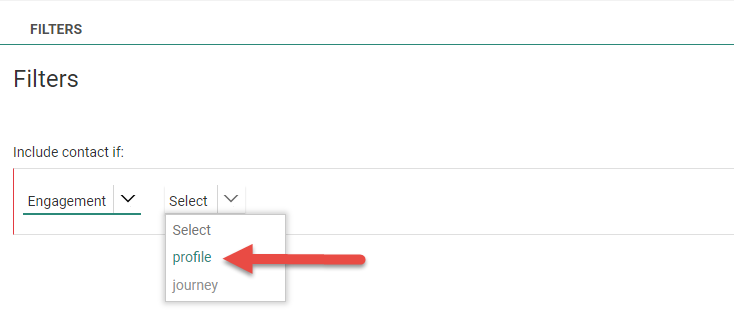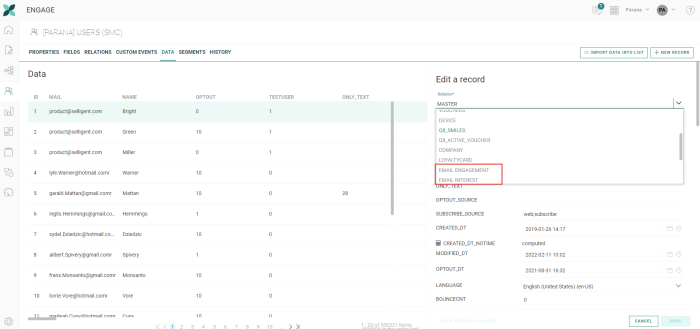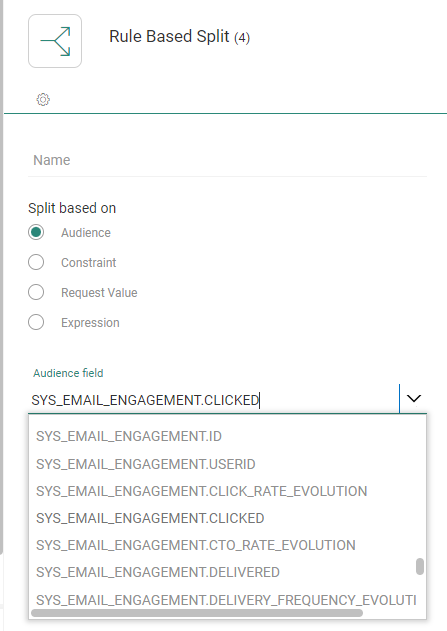Engagement Metrics
Engagement metrics needs to be activated on request for the environment. Once this is activated, it is possible to use the Engagement Metrics data in your environment for segmentation, personalization, filtering, export etc.
Engagement Metrics, what exactly is that?
When targeting your audience, it is important to know who they are, how active they are, what their interest is, etc so you can communicate with them with the right content at the right time. Marigold Engage does that in many different ways with features such as Send-Time Optimization, Smart Content, Segmentation and Filtering.
Engagement Metrics is a feature that allows to collect data on the contact's interaction, activity and device usage. The data collected spans a time frame of 90 days. This time frame is based on the delivery date of the message. So, when a message was delivered more than 90 days ago but viewed within the last 90 days, that view will not be counted.
For Recurring Batch Journeys, each delivery per contact is supported and metrics are stored for all messages delivered within the last 90 days.
Some use cases are:
- increase email deliverability and only target contacts that have been active in the last 3 months.
- Re-activate contacts that haven't been active for x months and try to re-engage them with an interesting offer.
What data is collected with Engagement Metrics?
These metrics are collected for messages delivered within the given time frame of 90 days. So, when a message was delivered more than 90 days ago but viewed within the last 90 days, that view will not be counted.
Note: Only real activity is taken into account when storing data in the engagement profile. Interactions that are flagged as a bot are excluded from the metrics.
For an overview of the Engagement metrics, check this topic.
What is the time range over which data is collected?
By default, data is gathered and leveraged over the last 90 days. This implies that for example the click rate is based on the last 90 days.
Note: This is a setting on your environment. If you want to extend these 90 days to a longer period of time, please contact support.
All, data is kept forever.
Engagement Metrics Related Scopes
Scopes appear in multiple areas of the application, such as the Constraint Editor, Personalization Dialog, Visibility Constraint and when Personalization fields are displayed in content.
When an Audience List is created and Engagement Metrics is active, automatically the extended profile 'Email engagement' is created and with that an additional scope, linked to that Audience List.
- SYS_EMAIL_ENGAGEMENT
This scope refers to the underlying database table, which stores the engagement data for the email channel. The table name will be something like: EMAIL_ENGAGEMENT_DATA-L1 where L1 is the ID of the Audience List.
Note: When Engagement Metrics is activated after the Audience List was created, the scope is generated retroactively.
How does it work?
Engagement Metrics is all about tracking a person's interactions, storing this information in a profile extension and generating aggregates on this data to optimize customer communication.
To start with, Engagement Metrics needs to be activated on request for your environment.
Once it is active Engagement data is tracked by default and stored in a profile extension of the Audience list (Email Engagement).
Technical note:
When this feature is activated on the environment, the Email Engagement profile will be:
* retroactively created for all existing Audience Lists.
* automatically added to each new Audience List upon creation.
When an Audience List is shared with other Organizations, its metrics are then made available cross-Organization.
Using Engagement Metrics data
Important note: Although only data from the last 90 days is used for all EMIT calculations, the first and last date fields (such as DELIVERED_LASTDT, CLICKED_LASTDT, OPENED_LASTDT, EML_DELIVERY_DT_FIRST, EML_OPEN_DT_FIRST, EML_CLICK_DT_FIRST) will also take into account data from before that 90 day period. This means that segments based on these fields, will contain more contacts than segments that use any of the other metrics.
From the Data Tab in an Audience List
The data in the Engagement profile extensions can be consulted from the Data tab in the Audience List.
Select the profile extension from the Relation field to view the data for a selected contact in the audience:
This information can be used to then filter the audience.
In the Constraint Builder
For example, when creating a dynamic segment, the data is available when defining the filter.
For the engagement data, select Engagement and then profile.

In Personalization Dialog
When personalizing messages, the engagement data can be used through the scopes SYS_EMAIL_ENGAGEMENT.
Once the fields have been selected, they will be visible from the message design with their corresponding scopes.
In Visibility Constraints
The engagement data can be used to define Visibility Constraints for a message.
In the Audience filter and Split Components
When creating a Custom Journey, audience filtering is possible using the engagement data. This can be done in the Audience Filter Component but also when performing a Rule Based Split on the audience for example.





